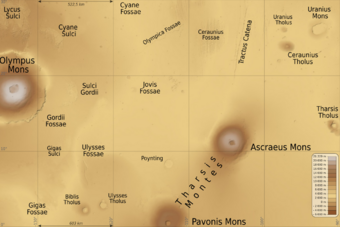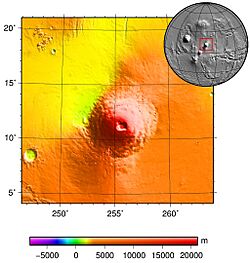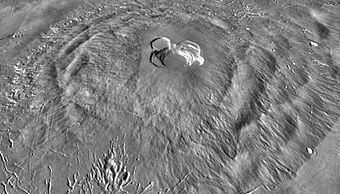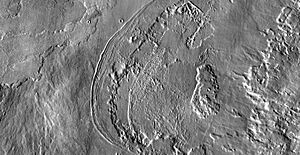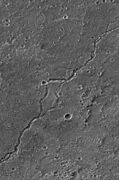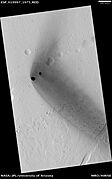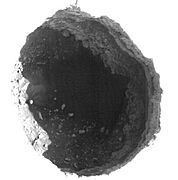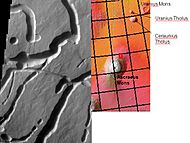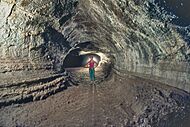Ascraeus Mons facts for kids
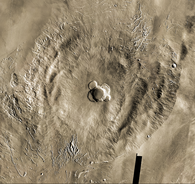 |
|
| Feature type | Shield volcano |
|---|---|
| Location | Central Tharsis Rise, Mars |
| Coordinates | 11°55′N 255°55′E / 11.92°N 255.92°E |
| Peak |
|
| Discoverer | Mariner 9 |
| Eponym | Latin for Ascraeus Mountain |
Ascraeus Mons is a giant shield volcano on the planet Mars. It's located in a volcanic region called Tharsis. It is the tallest of three huge volcanoes known as the Tharsis Montes. This makes it one of the tallest mountains in our entire solar system!
Contents
How Was Ascraeus Mons Discovered?
Long before we sent spacecraft to Mars, astronomers looking through telescopes saw bright and dark patches on the planet. They gave these patches names. The area where Ascraeus Mons is located was called Ascraeus Lacus.
The volcano itself was first seen up close by the Mariner 9 spacecraft in 1971. When Mariner 9 arrived at Mars, a huge dust storm covered the entire planet! Only four dark spots could be seen poking through the top of the dust clouds. One of these was called "North Spot."
As the dust settled, scientists realized these spots were the tops of gigantic volcanoes. "North Spot" was soon given its official name, Ascraeus Mons.
What Does Its Name Mean?
The name comes from an old feature map of Mars. The spot was called Ascraeus Lacus. This was named after Ascra, the ancient Greek hometown of the poet Hesiod. The word "ascraeus" meant something rural or from the countryside. In 1973, the volcano was officially named Ascraeus Mons, which is Latin for "Ascraeus Mountain."
What Does Ascraeus Mons Look Like?
Where Is It on Mars?
Ascraeus Mons is in the western part of Mars, in a huge volcanic area called the Tharsis quadrangle. It's part of a chain of three volcanoes called the Tharsis Montes. The middle volcano, Pavonis Mons, is about 500 km away.
How Big Is It?
Ascraeus Mons is enormous! It's about 480 km (300 miles) across, which is about the size of the state of Arizona. It is the second-tallest mountain on Mars, reaching over 18 km (11 miles) high. That's more than twice as tall as Mount Everest!
Even though it's so tall, the volcano has very gentle slopes. If you were standing on it, you might not even realize you were on a mountain because it's so wide.
Giant Lava Aprons
On the northeast and southwest sides of the volcano, there are huge "aprons" of hardened lava. These lava flows spread out for more than 100 km (62 miles) into the plains below. These aprons show that giant cracks in the Martian crust likely fed the volcano and its lava flows.
A Dusty Giant
Like much of the Tharsis region, Ascraeus Mons is covered in a thick layer of fine, bright dust. This is because it's so high up that the Martian atmosphere is very thin. The air is too thin to blow the dust away once it settles. The air pressure at the top of Ascraeus Mons is only 17% of the average pressure at the surface of Mars.
Mysterious Pits in the Plains
In 2010, the Mars Reconnaissance Orbiter (MRO) took pictures of two dark, deep pits in the lava plains near the volcano. These pits look like giant holes in the ground. Scientists think they might be collapsed lava tubes. A lava tube is like a cave that was formed when the outside of a lava flow hardened, but the lava inside kept flowing and drained away. These pits could be openings to huge underground caves on Mars!
How Was Ascraeus Mons Formed?
Ascraeus Mons is a shield volcano. This means it was built up slowly over millions of years by thousands of eruptions of very runny lava. This is similar to how the Hawaiian Islands were formed on Earth.
Rivers of Rock
The sides of Ascraeus Mons are covered with long, winding channels and flows of old lava. Some of these flows have ridges along their edges called levees. These formed when the edges of the lava flow cooled and hardened first, creating a channel for the hot lava in the middle.
Scientists have studied these lava flows to figure out what the lava was like. They found it was very fluid and runny, much like the basaltic lava that erupts in Hawaii and Iceland. The lava that built Ascraeus Mons was probably rough and blocky, known as ʻaʻā lava.
Giant Steps on Its Slopes
The sides of Ascraeus Mons aren't perfectly smooth. They have a rumpled look because of huge, rounded terraces or steps. These steps can be up to 100 km (62 miles) long and 3 km (1.9 miles) high! Scientists think these were formed by the volcano's incredible weight, which caused the ground to buckle and shift over time.
The Caldera Complex
At the very top of the volcano is a caldera complex. A caldera is a large crater that forms when the ground collapses after a magma chamber underground empties during an eruption. Ascraeus Mons has a main central caldera and four other connected ones.
By counting the craters on top of these calderas, scientists can estimate their age. The youngest caldera is about 100 million years old, while the oldest might be over 800 million years old. This tells us that Ascraeus Mons was an active volcano for a very, very long time.
Was There Ice on the Volcano?
On the western side of the volcano, there is a strange, fan-shaped area with knobby hills and ridges. For a long time, scientists weren't sure what caused this. Now, many believe that these are the remains of a giant glacier!
Mars's tilt changes over long cycles. When the tilt is high, the poles get more sunlight, and ice can build up near the equator. It's thought that during one of these periods, a huge ice sheet formed on the side of Ascraeus Mons.
Gallery
-
Channels on the volcano's side. Some could be collapsed lava tubes.
-
Valentine Cave in Lava Beds National Monument, California. This shows the classic tube shape; the grooves on the wall mark former flow levels. Pits near volcanic regions of Mars may be openings to caves like this.
See also
- List of mountains on Mars by height
- Tharsis quadrangle
- List of tallest mountains in the Solar System


